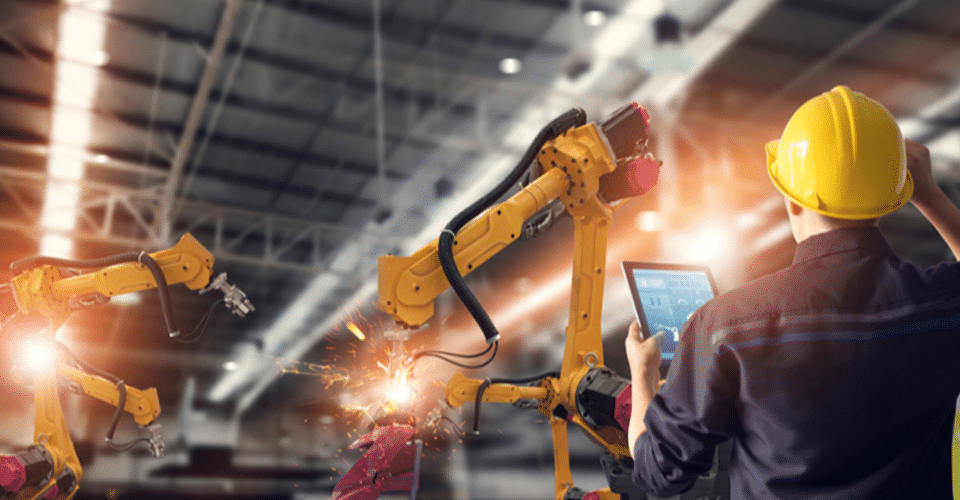Busting 5 myths of digital transformation in manufacturing

Author: Fraser Thomson, Business Development Director at Cimlogic
Manufacturers must adopt digital technology to meet increasing customer demands such as faster delivery times, better supply chain efficiency and to grow their market share. Technology advancements are moving faster than ever before, so how can manufacturers keep on top of their game, whilst overcoming the widespread misconceptions of digital transformation?
Myth #1 “Digital transformation means spending a lot of money”
It’s common for smaller manufacturers to feel like they cannot afford to invest in digital transformation projects, but in fact, money doesn’t always mean the greatest value and success is achieved. With the emergence of technologies such as IIoT, mobile devices, wireless connectivity and subscription pricing models, it’s now easier than ever for SME’s to implement digital technologies, without the need to commit to expensive technologies from high-price vendors.
The digital shift in manufacturing is being driven by investments in industrial and manufacturing software applications, which is set to grow from £13.4bn in 2019 to £20.7bn in 2024 – an increase of more than 50%, according to data released by ABI Research*. According to new research, MES software is likely to be the highest growth area as manufacturers strive to enhance both production line and machine performance. As software applications become more affordable and accessible the belief that spending huge amounts of money on digital transformation becomes less credible.
Myth #2 “I will have to throw everything away and build a new factory”
It’s typical for business owners to lack confidence in adopting new technologies and to think that a ‘smart factory’ is a newly built facility with all the mod cons. In fact, the term ‘smart factory’ can be described as a highly digitalised and connected environment where machinery and equipment are able to improve processes through automation. Today’s smart sensors and mobile devices make it possible to extract data from production line machinery, including that of legacy machines. Smart devices are much more affordable, making it quicker and easier to get instant shop floor data to the decision-makers. Using technologies such as these removes the need for the ‘knock it down and start again’ approach.
Myth #3 “Digital transformation is an IT Project”
As defined by whatis.com, IT/OT convergence is the ‘integration of information technology (IT) systems used for data-centric computing with operational technology (OT) systems used to monitor events, processes and devices and make adjustments in enterprise and industrial operations’. Until recently these two were unlikely to be linked and were actively discouraged in order to protect the OT devices (on the production line) and ensure their continued operation from the potential dangers on the internet-connected IT network. Today, however, things are very different as IT and OT networks are being squeezed together by demands that are impossible to ignore, such as IT security. Manufacturers must bring together OT and IT functions to realise the value that can be gained in terms of efficiencies. It is particularly important within the realms of IIoT technology adoption, as IIoT is about automating processes and using connected devices to gather, receive and send information; all heavily reliant on having a good IT network infrastructure.
Myth #4 “Robots will take over our jobs”
It is well known that automation adoption is seen as a great threat to the job market. As manufacturers adopt digital technologies and automation takes over the mundane tasks, a shift will be seen in the required skill set of staff. Digital technology systems will control more aspects of manufacturing operations, therefore the need for digital and analytical roles will grow. This collaborative relationship between people and automation is termed ‘Cobotics’ and is becoming increasingly important. According to the Annual Manufacturing Report 2020, 89% of recipients say the replacement of many shop floor jobs by automation means new recruits need to be even more highly skilled to operate our digital future. Rather than viewing technology as a threat, manufacturers must place more emphasis on staff development, ready for these future digital roles.
Myth #5 “Our workforce doesn’t have the correct skills to digitalise”
There’s a misconception that a whole new digital workforce will need to be employed, which just isn’t the case. Yes, the workforce dynamics may change as employees adapt to new technologies and processes. But in fact, you’ll be surprised to find out how digitally savvy your staff really are. Smartphones, iPads, Hive heating systems and Amazon Echo’s are probably used regularly by your staff. So, what are the main barriers to introducing digital technology on the shop floor – cost, buy-in, culture, IT infrastructure? Management must firstly promote the benefits of technology to their staff and highlight why it will make their job easier and more enjoyable. For example, ask your staff what impact it would have on their job if they could instantly see how fast their machine was running and when it is producing over target? According to the Annual Manufacturing Report, 2020 86% of recipients have in place a policy for upskilling and retaining their workforce and believe in life-long learning. This is indeed the correct attitude to have and is absolutely necessary when manufacturers are creating a digital workforce of the future.
* https://www.themanufacturer.com/articles/global-spend-on-industrial-software-to-hit-20-7bn-in-2024/
Register to watch our on-demand webinars to learn more about how to improve OEE, manage Quality and adopt IIoT technologies to drive manufacturing productivity. http://bit.ly/cimlogic-webinars
